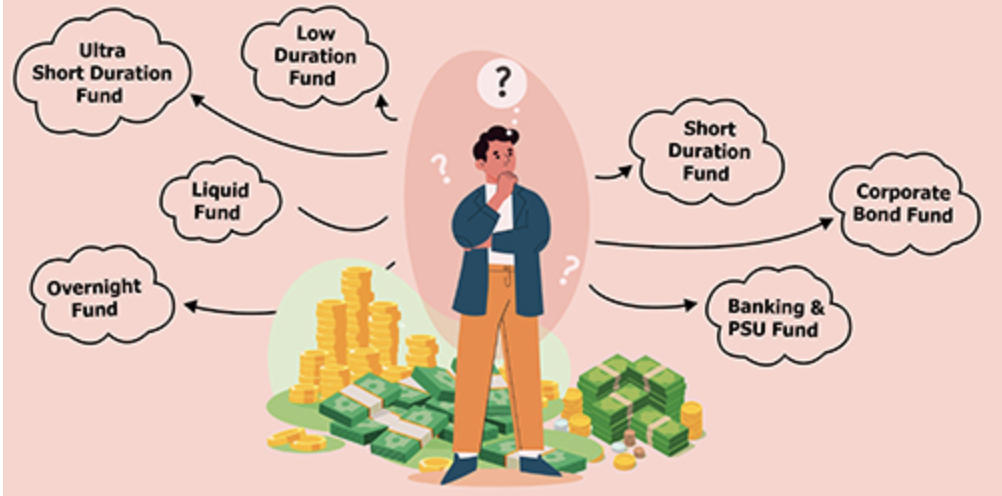There seems to be a common misconception in investing circles, that debt funds are the way to go when the market dips or proves to be unstable. While timing the market is a useless endeavor, let’s try to understand if debt funds are suitable for you in 2022 and whether there is a right time to invest in debt funds exactly?
What are debt funds?
Simply put, companies that issue debt instruments ‘borrow’ funds from their investors as a form of a loan, to raise money. This loan they issue is then returned to the investors with a certain interest, making it a profitable investment for the lender/investor.
Debt funds offered in the market invest in these types of ‘loaned’ securities such as fixed income, corporate bonds, government schemes, money market instruments, etc. The rate of interest and the maturity period (ie. how long you should stay invested) in debt funds is already ‘fixed’, hence the name ‘fixed-income’.
This is of course, different from investing in equities or other investment vehicles, where the returns are dynamic and can not be determined solidly, they may depend on the rise and fall of markets or any ‘n’ number of different factors. This is why debt funds seem to have gotten the tag of ‘safe’ investments.
With rising interest rates, as imposed by the RBI this year, however, the rate of returns debt funds offer does get pulled down. They are still the safer asset class investors are seeking in times of market turbulence, but investing in debt should be at par with your larger investing goals and overall portfolio.
What is credit rating in debt funds?
To understand how debt funds work, we must first understand how debt funds are accredited. Debt funds- no matter which securities they invest in- do so on the basis of each securities credit rating.
A securities credit rating is the possibility of the issuer defaulting on this loan they have undertaken. This is the inherent risk most investors don’t consider while investing in debt funds. While debt funds do promise a fixed interest, there is always the risk- that the issuer may default on them. The possibility of this risk does decrease with higher-rated credit instruments, but it is still there.
It is the responsibility of the debt fund’s fund manager to pick securities with a high credit rating to ensure that investors get both - their steady returns and the principal amount on maturity. Additionally, this also determines the debt fund’s volatility, as a fund with a higher percentage of high-rated funds is more stable, and debt funds come in variable volatilities.
The credit rating of a security or instrument is undertaken by non-partisan third-party credit rating agencies, the prominent among which are- Crisil and ICRA. These agencies perform various checks with thorough scrutiny before accrediting said securities, and perform under the watchful eye of the SEBI.
Debt fund managers also have to adjust their strategy taking maturity periods and macroeconomic conditions into perspective. For instance, during a high-interest rate regime such as ours is currently, shorter-term debt instruments offer more promise, and conversely, during lower interest rate periods, the fund should compromise more longer-term debt securities.
Types of Debt funds based on maturity
Debt funds are primarily categorized into short-term and medium/long-term debt funds. These are determined on the basis of the maturity of its ensuing debt instruments have. So, funds that have an investing period of 3 months-1 years are categorized as short-term debt funds while those that have a 3-5 year-long investing period can be classified as a medium-term debt funds.
Is a short-term or a long-term debt fund right for me?
Well, that depends on what your goals are. Short-term debt funds are more suitable when interest rates are running high in the economy, or for conservative investors whose primary investment objective is the conservation of wealth instead of high returns. In such cases, short-term debt funds are the most promising as they can offer up to 10% of returns.
Short-term and long-term debt funds are also ideal for investors who want to reduce the overall risk of their investments, as an alternative to bank FDs or savings accounts since they don’t offer as high returns comparatively.
Some different types of debt funds
Debt funds are of various types based on criteria, which to invest in would depend on your goals and your risk appetite accordingly, some popular types of debt funds in India include,
1. Ultra short-term debt funds- As the name suggests, funds have a really short investing period, usually from 3-6 months. They yield higher returns than FDs and bank accounts and are suitable for conserving a corpus for a short amount of time.
2.Overnight funds- Similar to ultra-short, overnight debt funds are an option when you want to safeguard some money for an extremely short amount of time, like a few days (or even overnight), they offer similar or on par returns with FDs.
3.Liquid Funds- Liquid funds invest in debt instruments that have a quick maturity period, usually within 91 days. They do not attract any exit costs which make them readily available to withdraw from should the need arise. Liquid funds are a great option to invest in for emergency or rainy day funds, as they do yield better than FDs, but additionally invest in safe and high-rated instruments only.
4.Income funds- Income funds invest in varying debt instruments - like government securities or corporate bonds, but are typically suggested for long-term investors to hedge their portfolio. Since they are more of a long-term option they do carry a higher amount of risk. Their maturity period can range uptil 6 years.
5.Corporate bond funds- These fund’s allocation includes atleast 80% in high-credit-rated corporate bonds. These are a good option for investors looking for both decent returns as well as low risk. It is imperative that you assess the credit ratings of the constituent securities before investing though.
6.Gilt funds- These fund’s allocation includes atleast 80% in government (both state or central) backed securities. Since the constituent securities are backed by the government they are considered to not have any credit risk and your capital remains safe. They do however, have varying levels of maturity periods and are best for investors looking to onvest only in government backed instruments for long-term. Another thing to note is that since there is no credit risk involved they are susceptible to chaning interest rates.
7.Fixed Maturity Plans- As the name suggests, Fixed Maturity Plans invest in debt securities that have an identical maturity period. For eg, if the FMP is of 1 year, then all its constituent securities will have a maturity period of 1 year. Unlike all the other mentioned funds, FMPs are close-ended, which means that you can only invest in them during their MFO stage and redeem them only at maturity. FMPs are available at different maturity periods and are subject to change in interest rates.
There are many other types of debt instruments and debt funds on the basis of these instruments or a mix of both. To really understand which one of these is right for you, will depend on what you require our of investing, what your risk tolerance is, and how long you choose to invest for based on your goal duration.
At Stack, we help you cut this hassle out completely. Your Stacks include debt fund allocations based on your investing goals, risk and time horizon- and which include only certified high-credit rated securities, verified and handpicked by our team of experts, so you don’t have to.


